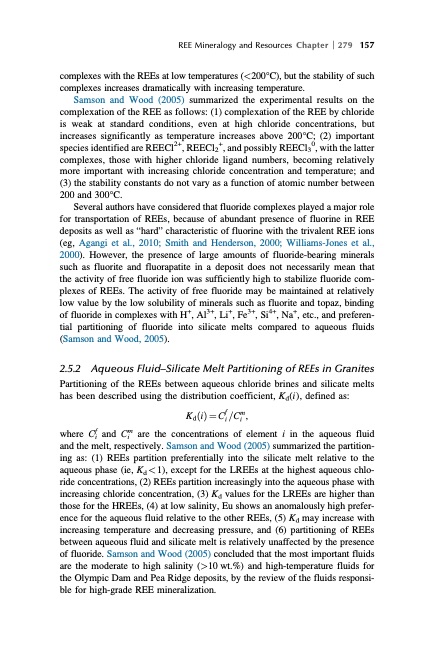
PDF Publication Title:
Text from PDF Page: 193
REE Mineralogy and Resources Chapter 279 157 complexes with the REEs at low temperatures (<200°C), but the stability of such complexes increases dramatically with increasing temperature. Samson and Wood (2005) summarized the experimental results on the complexation of the REE as follows: (1) complexation of the REE by chloride is weak at standard conditions, even at high chloride concentrations, but increases significantly as temperature increases above 200°C; (2) important species identified are REECl2+, REECl2+, and possibly REECl30, with the latter complexes, those with higher chloride ligand numbers, becoming relatively more important with increasing chloride concentration and temperature; and (3) the stability constants do not vary as a function of atomic number between 200 and 300°C. Several authors have considered that fluoride complexes played a major role for transportation of REEs, because of abundant presence of fluorine in REE deposits as well as “hard” characteristic of fluorine with the trivalent REE ions (eg, Agangi et al., 2010; Smith and Henderson, 2000; Williams-Jones et al., 2000). However, the presence of large amounts of fluoride-bearing minerals such as fluorite and fluorapatite in a deposit does not necessarily mean that the activity of free fluoride ion was sufficiently high to stabilize fluoride com- plexes of REEs. The activity of free fluoride may be maintained at relatively low value by the low solubility of minerals such as fluorite and topaz, binding of fluoride in complexes with H+, Al3+, Li+, Fe3+, Si4+, Na+, etc., and preferen- tial partitioning of fluoride into silicate melts compared to aqueous fluids (Samson and Wood, 2005). 2.5.2 Aqueous Fluid–Silicate Melt Partitioning of REEs in Granites Partitioning of the REEs between aqueous chloride brines and silicate melts has been described using the distribution coefficient, Kd(i), defined as: K d ð i Þ 1⁄4 C f i = C mi , where Cfi and Cmi are the concentrations of element i in the aqueous fluid and the melt, respectively. Samson and Wood (2005) summarized the partition- ing as: (1) REEs partition preferentially into the silicate melt relative to the aqueous phase (ie, Kd < 1), except for the LREEs at the highest aqueous chlo- ride concentrations, (2) REEs partition increasingly into the aqueous phase with increasing chloride concentration, (3) Kd values for the LREEs are higher than those for the HREEs, (4) at low salinity, Eu shows an anomalously high prefer- ence for the aqueous fluid relative to the other REEs, (5) Kd may increase with increasing temperature and decreasing pressure, and (6) partitioning of REEs between aqueous fluid and silicate melt is relatively unaffected by the presence of fluoride. Samson and Wood (2005) concluded that the most important fluids are the moderate to high salinity (>10 wt.%) and high-temperature fluids for the Olympic Dam and Pea Ridge deposits, by the review of the fluids responsi- ble for high-grade REE mineralization.PDF Image | HANDBOOK ON THE PHYSICS AND CHEMISTRY OF RARE EARTHS

PDF Search Title:
HANDBOOK ON THE PHYSICS AND CHEMISTRY OF RARE EARTHSOriginal File Name Searched:
Chemistry-Rare-Earths-49.pdfDIY PDF Search: Google It | Yahoo | Bing
Sulfur Deposition on Carbon Nanofibers using Supercritical CO2 Sulfur Deposition on Carbon Nanofibers using Supercritical CO2. Gamma sulfur also known as mother of pearl sulfur and nacreous sulfur... More Info
CO2 Organic Rankine Cycle Experimenter Platform The supercritical CO2 phase change system is both a heat pump and organic rankine cycle which can be used for those purposes and as a supercritical extractor for advanced subcritical and supercritical extraction technology. Uses include producing nanoparticles, precious metal CO2 extraction, lithium battery recycling, and other applications... More Info
| CONTACT TEL: 608-238-6001 Email: greg@infinityturbine.com | RSS | AMP |